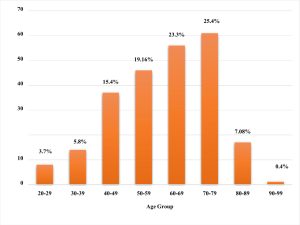
ABSTRACT
Background: Hypertension increases the risk of cerebrovascular illness and cognitive decline by directly affecting the cerebral artery vasomotor function causing premature death. As the retina and the brain have similar embryological origins, any microvascular alterations in the retina can detect subtle changes in the cerebral vasculature, which can be used to suspect the diagnosis of cerebral dysfunctions. The purpose of our study is to determine an association between Hypertensive Retinopathy (HTRP) and stroke. Materials and Methods: This is a prospective observational study, 240 hypertensive patients were selected based on the inclusion criteria involving all age groups, Patients’ information was gathered using patient data collecting forms and the following were obtained: Demographic details, medical history, diagnosis and laboratory data was obtained. The data was sorted according to JNC-8 criteria and Keith-Wagner Classification for HTRP and entered into Microsoft excel and analyzed using SPSS software 26 version and the association was determined using Pearson chi-square and Pearson correlation. Results: Out of 240 hypertensive patients 196 had stroke and 84 had HTRP. The association between HTRP and stroke was assessed in 40 individuals with both stroke and HTRP, A Pearson chi-square showed that there is a significant association between the two variables at 0.05 level [χ2 (4, N=40)=10.952a, p=.027)]. Conclusion: From our study we conclude that there is a statistically significant (p=<0.05) association between HTRP and stroke. Hence it is necessary to promote diagnosis of HTRP as an indicator for stroke.
